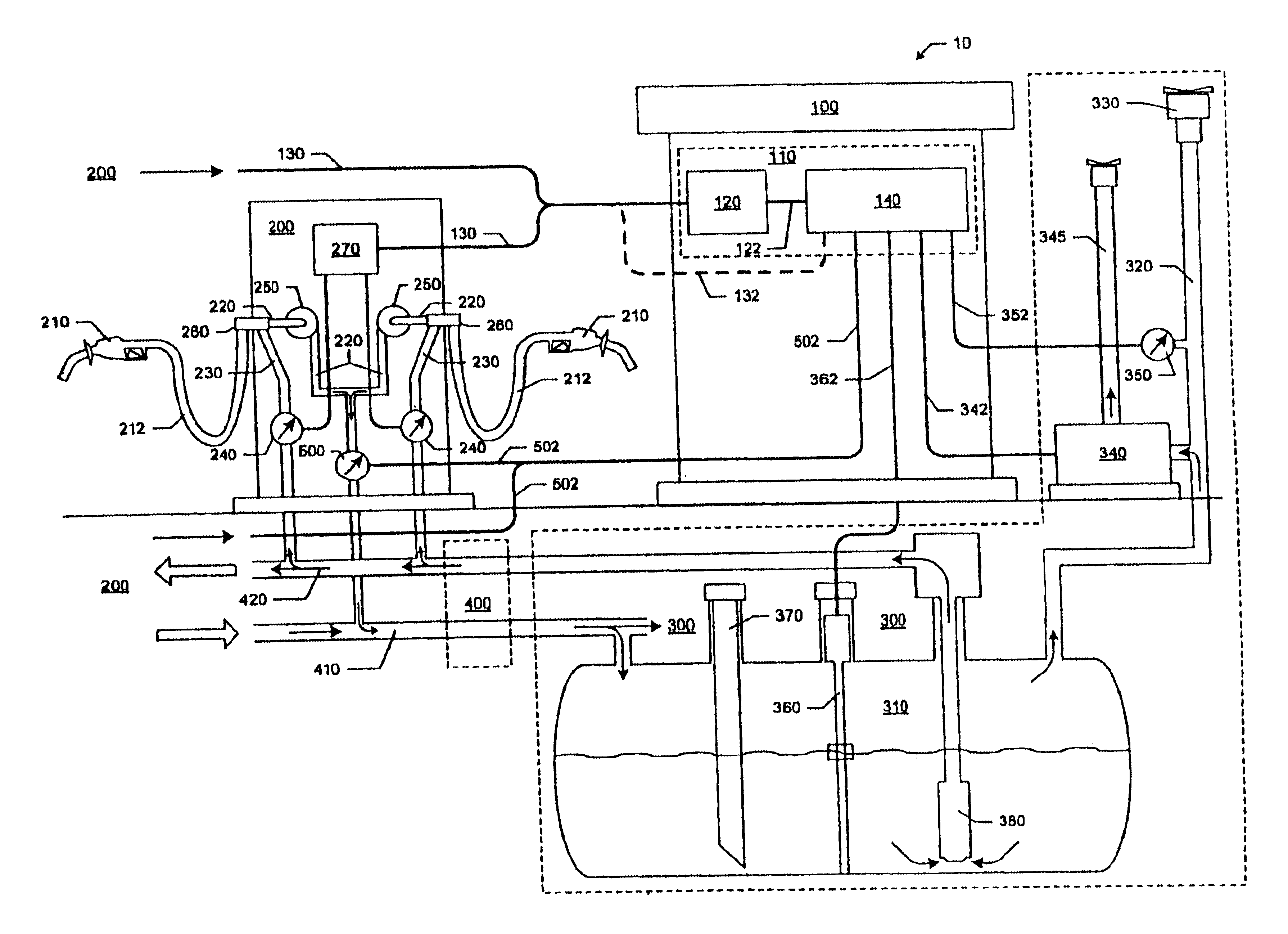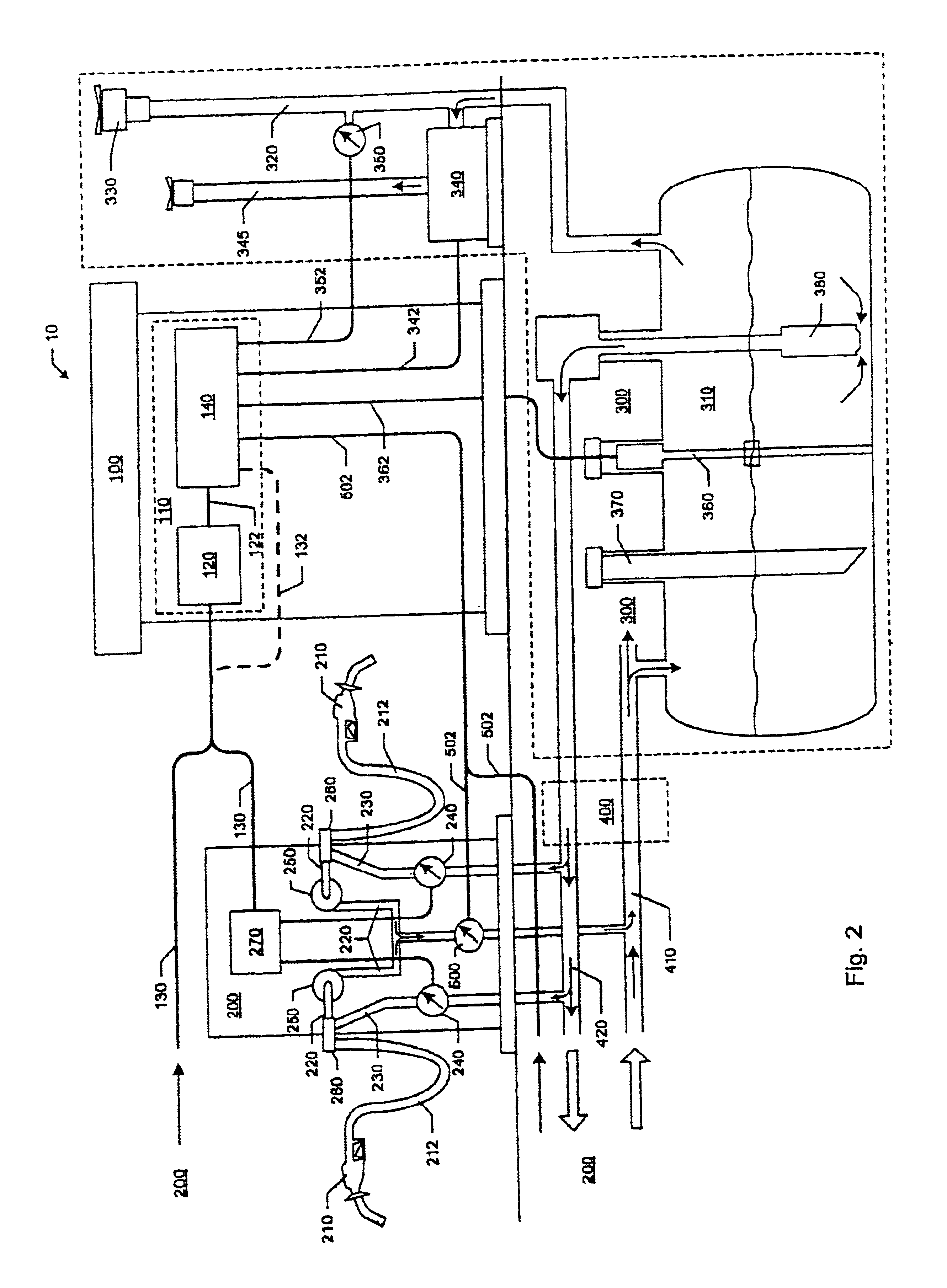Fueling system vapor recovery and containment performance monitor and method of operation thereof
a technology of vapor recovery and containment, which is applied in the direction of liquid transfer devices, packaging goods types, liquid handling, etc., can solve the problems of gasoline dispensing facilities (i.e. gasoline stations) often suffering from a loss of fuel to the atmosphere, inadequate reclamation, and substantial amounts of hydrocarbon vapors to the atmosphere, so as to reduce the number of devices
- Summary
- Abstract
- Description
- Claims
- Application Information
AI Technical Summary
Benefits of technology
Problems solved by technology
Method used
Image
Examples
first embodiment
[0037]the invention is described in connection with FIG. 1, which shows a vapor recovery and containment monitoring system for use in a liquid fuel dispensing facility 10. The dispensing facility 10 may include a station house 100, one or more fuel dispenser units 200, a main fuel storage system 300, means for connecting the dispenser units to the main fuel storage system 400, and one or more vapor (or air) flow sensors (AFS's) 500.
[0038]The station house 100 may include a central electronic control and diagnostic arrangement 110 that includes a dispenser controller 120, dispenser current loop interface wiring 130 connecting the dispenser controller 120 with the dispenser unit(s) 200, and a combined data acquisition system / in-station diagnostic monitor 140. The dispenser controller 120 may be electrically connected to the monitor 140 by a first wiring bus 122. The interface wiring 130 may be electrically connected to the monitor 140 by a second wiring bus 132. The monitor 140 may in...
second embodiment
[0046]With reference to the invention shown in FIG. 2, it is appreciated that multiple AFS's 500 could be deployed to measure various groupings of dispensing point 210 vapor flows, down to a minimum of only two dispensing point vapor flows. The latter example may be realized by installing one AFS 500 in each dispenser housing 200, which typically contains two dispensing point's 210 (one dispensing point per dispenser side) or up to 6 dispensing points (hoses) in Multi-Product Dispensers (MPD's) (3 per side). The vapor flows piped through the vapor return passage 220 may be tied together to feed the single AFS 500 in the dispenser housing.
[0047]As stated above, the monitor 140 may connect to the dispenser controller 120, directly to the current loop interface wiring 130 or directly to the liquid fuel dispensing meter 240 to access the liquid fuel flow volume readings. The monitor 140 may also be connected to each AFS 500 at the facility 10 so as to be supplied with vapor flow amount ...
third embodiment
[0090]the invention concerns the use of a single vapor pressure sensor 350 (same as CARB requirement) to actively determine the tightness of the overall vapor containing elements of the facility including the fuel storage system 300, (which includes the vent pipe 320, pressure relief valve 330, etc.), the vapor return pipelines 410, the vapor / liquid splitter 260, the vapor return passages 220, the dispenser hose 212, the nozzle 210, etc. The vapor pressure sensor 350 may be connected anywhere in the fuel storage system 300 or the pipeline system 400, which includes but is not limited to the storage tank 310 vapor-space, the common vapor return pipeline 410, or the storage tank vent pipe 320. The vapor pressure sensor 350 may be used periodically to actively measure the leakage of vapors from the overall system instead of constantly measuring for leakage amount.
[0091]The method in accordance with the third embodiment of the invention may be carried out as follows. The monitor 140 may...
PUM
| Property | Measurement | Unit |
|---|---|---|
| threshold | aaaaa | aaaaa |
| pressure | aaaaa | aaaaa |
| pressure level | aaaaa | aaaaa |
Abstract
Description
Claims
Application Information
 Login to View More
Login to View More - R&D
- Intellectual Property
- Life Sciences
- Materials
- Tech Scout
- Unparalleled Data Quality
- Higher Quality Content
- 60% Fewer Hallucinations
Browse by: Latest US Patents, China's latest patents, Technical Efficacy Thesaurus, Application Domain, Technology Topic, Popular Technical Reports.
© 2025 PatSnap. All rights reserved.Legal|Privacy policy|Modern Slavery Act Transparency Statement|Sitemap|About US| Contact US: help@patsnap.com



